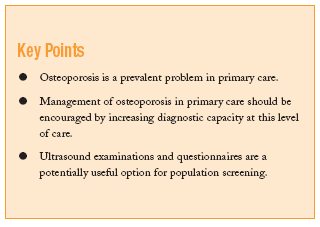In light of the results in the article titled "Prevalence of osteopenia and osteoporosis in postmenopausal women," which appears in this issue of Atención Primaria, the answer is yes, the prevalence of osteoporosis in our offices is high. According to data from this study, more than half of the women seen fulfilled some of the criteria for osteoporosis. Nevertheless, the impression is that primary care tends to emphasize the cardiovascular risks, with little mention of the risks of bone fractures.
The reasons for this unsatisfactory approach to osteoporosis are varied. Physicians receive little training in this topic, and this makes it difficult to judge the usefulness of the contradictory information they are subjected to from different sources (health authorities, journals, mass media, pharmaceutical industry, consensus documents, etc). As a result the physician's opinion varies depending on the impact of the information he or she receives. Moreover, because access is limited to bone densitometry, the gold standard of diagnostic methods,1 primary care physicians are uninterested in keeping up to date on a disease they cannot diagnose. Nor should we forget the findings of the ABOPAP study, which showed that 75% of all family physicians in Spain did not have access to bone densitometry, the only exceptions being the regions of Catalonia and a few other regions and individual centers where access was feasible.2,3
Personally, I believe the problem should be approached from two angles. Criteria developed by scientific societies should be used more widely to catalyze the development of clinical guidelines for the management of osteoporosis, but unfortunately distribution of these guidelines is conditioned by the interests of health authorities or the pharmaceutical industry. In addition, access should be facilitated to diagnostic tests such as bone densitometry or prescreening with peripheral ultrasound, as it is at the primary care level where interventions can be carried out most effectively.
We are all aware that osteoporosis is a risk factor for a more serious event--fracture--which is responsible for increased mortality and health care costs. Obviously not all cases of osteoporosis should be treated with medication, although this should be used when the risk of fracture is high whether because of genetic predisposition, previous fracture or very low t-score. A recent study showed that at a femoral t-score of 3 or lower, the risk of fracture is greatly increased, and pharmacological treatment is indicated.4
With regard to limited access to bone densitometry, the reasons argued by the health administration are based on its low cost-efficiency, since the results are not highly predictive of fracture. While this is true, we should remember that densitometry results are the best marker available for clinicians to evaluate the risk of a first fracture. The costs, in fact, vary widely between different areas. In Barcelona the cost of a single scan ranges from approximately 30 to 40 euros, not an excessively high figure compared to the cost of treatment which is not indicated.
Evidently, the risk implied by a given t-score varies depending on other risk factors, but a t-score of 4 remains an indicator of a high risk of fracture even in the absence of other accompanying risk factors. As the study by Reyes Balaguer and Moreno Olmos shows, ultrasound is a potentially useful technique for population screening because of its ease of use, but we also need to remember that it is a nonstandardized technique and that the cut-off point for osteoporosis can differ depending on the apparatus and model. This is not the case with dual-energy x-ray absorptiometry, for which the standard cut-off point is a t-score of 2.5 for the lumbar spine and femoral neck.
The use of questionnaires (e.g., ORAI, OST, OSIRIS, or SCORE) has been proposed in an attempt to obviate the need for densitometry. The cost-efficiency of these instruments has been evaluated in comparison to the cost of bone densitometry in Belgium--estimated at 40 euros.5,6 Questionnaires can bring the cost per case diagnosed down from 117 euros (no questionnaire) to 85 euros (OSIRIS questionnaire) or 103 euros (SCORE questionnaire). However, these results were obtained at a cost of failure to diagnose 25% and 11% respectively of all cases of osteoporosis. Reliance on questionnaires alone to diagnose osteoporosis must therefore be viewed with caution.








